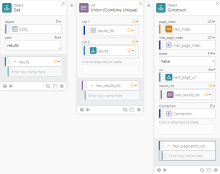Paginate: API endpoint
This function card is only available in Connector Builder.
This example builds on the concepts and implementation introduced in Paginate: set a maximum page index.
The specific behaviors of paginating against an API endpoint vary depending on the API. For this example, consider a simple link header that includes a URL for the next page of records.
To expand on the Paginate: set a maximum page index exercise, add some new key and value pairs to the pagination object:
-
url: This is the complete URL used to retrieve the first page of records. In many services, this contains both a limit and an offset value.
-
limit: Determines how many records to retrieve, starting from the offset.
-
offset: Position in the data set of the last record retrieved.
-
-
results_list: This is an empty list of objects to which each page of new records is added.
-
Connection: The connection information that is passed along to the helper flow. To include a connection, click Add event and select Action.
The resulting object looks like:
{
"page_index": 0,
"max_page_index": 10,
"url": "https://app.scaleft.com/v1/teams/demo/projects?limit=200&offset=0",
"results_list": [],
"break": false,
"Connection":{
"blob":{
"api_key":"<apikeystring>"
}
}
}Helper flow
The Paginate function requires a helper flow. The inputs defined in the helper flow need to match the keys you defined in the pagination object:
-
page_index
-
max_page_index
-
break
-
url
-
results_list
-
Connection
Use the url value to call the service using the HTTP Raw Request function. After you receive a response, the helper flow manages the url and results_list to prepare for the next iteration of the pagination function.
Extract the link header from the headers object and the page of results from the body object using Get object cards.
After a page of results has been extracted from the response, it needs to be added to any existing results from previous pagination iterations using the List Union function. Then rebuild the pagination object with the new values collected within the helper flow.
The resulting object looks like:
{
"page_index": 1,
"max_page_index": 10,
"break": false,
"url": "https://app.scaleft.com/v1/teams/demo/projects?limit=200&offset=200",
"results_list": [
"1",
"2",
"3",
"4",
"5",
"..."
],
"Connection": {
"blob": {
"api_key": "<apikeystring>"
}
}
}Finally, you need to determine how the API indicates that there are no more result pages so the pagination should halt. For example, the service might drop the link key from the header after the last page of results is sent.
Therefore, if the link key is missing or empty, then the break key must be removed from the pagination object using the Unset object function. When the pagination object is returned to the parent flow without the break key, the pagination stops.
When you run the parent flow, the final object looks like the following:
{
"page_index":6,
"max_page_index":10,
"url": "",
"results_list":[
"1",
"2",
"3",
"4",
"5",
"6",
"7",
"8",
"9",
"10",
"..."
],
"Connection":{
"blob":{
"api_key":"<apikeystring>"
}
}
}



